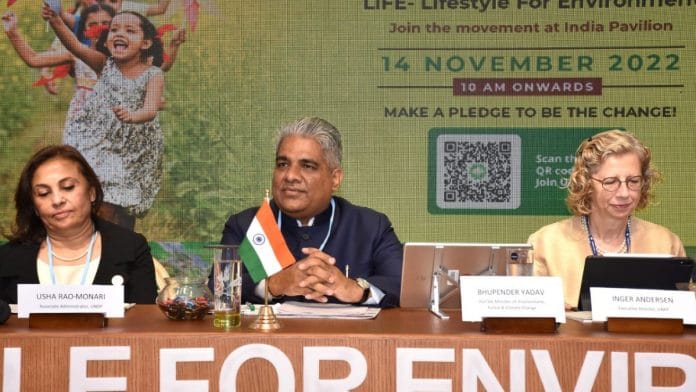Sharm el-Sheikh, Egypt: India Monday released its long-term strategy of achieving net-zero emissions by 2070 at the ongoing COP27 in Egypt’s Sharm el-Sheikh. It came a year after Prime Minister Narendra Modi announced India’s net-zero target as part of the ambitious “panchamrit” pledge at the COP26.
Called the ‘Long Term Low Emission Development Strategy’ (LT-LEDS), the 121-page document focuses on “strategic transition” of several high-emission sectors, namely electricity and transport; urbanisation; carbon dioxide removal for industry; forests; finance and investments. The plan will also focus on improving research, innovation, climate adaptation and resilience.
“With this release, India joins the select list of less than 60 parties that have submitted their long-term strategies to the UNFCCC (United Nations Framework Convention on Climate Change),” Environment Minister Bhupender Yadav said at the launch of the report.
He added, “The two themes of ‘climate justice’ and ‘sustainable lifestyles’ are emphasised in our strategy alongside the UNFCCC principles of equity and common but differentiated responsibilities.”
The release comes amid tense negotiations between countries on how to reduce carbon emissions to “well below” 2 degrees Celsius and preferably 1.5 degrees, above pre-industrial levels, in order to limit global warming, as acknowledged under the Paris Agreement.
In its latest World Energy Outlook report, the International Energy Agency had said that India’s ambition to achieve net-zero by 2070 played a significant role in limiting global heating.
Developing countries, including India, have demanded that their rich counterparts reach net-zero emissions before 2050 to give the 1.5 degrees Celsius goal a fighting chance of survival. The world is projected to cross 2.3 degrees Celsius warming if drastic changes aren’t enacted immediately.
At the launch, Yadav also stressed that the plan was based on India’s right to an equitable share of the remaining carbon budget to limit global warming to 2 degrees Celsius. During the negotiations, the Indian delegation had been driving home the point that any mitigation target to reduce emissions must account for an equitable distribution of the carbon budget, Hindustan Times reported.
“This is the practical implementation of India’s call for ‘climate justice’. We have ensured that the strategy emphasises energy security, energy access and employment while keeping focus on our vision of Atmanirbhar Bharat or self-reliant India, and Make in India,” he said.
Also read: Why definition of climate finance remains a major bone of contention at COP27 talks
Energy transition
Among strategies outlined in the plan are expanding and stabilising the renewable electricity grid, phasing down coal, increasing the adoption of electric vehicles, research and development into carbon removal and capture technologies, as well as the restoration and conservation of forests.
By 2032, India will also scale up its nuclear capacity by three folds, expand production and manufacturing power of green hydrogen under the Green Hydrogen Mission, the minister said.
A majority of India’s electricity generation is coal dependent, with only around 20 per cent coming from renewable sources. India pledged to increase its installed renewable generation capacity to 50 per cent, as part of its Nationally Determined Contributions (NDCs), or long term climate goals.
The transition to low-cost development will cost “tens of trillions” of dollars, according to the document. Yadav also said that the plan makes it “clear that this effort to transform India’s economy would require huge financial resources”. India had demanded at least one trillion dollars in climate finance during last year’s negotiations.
“India’s LT-LEDS should be viewed as a living document. Future iterations should emphasise robust and transparent modelling towards net-zero by 2070, clearer identification of sectoral co-benefits and trade-offs, and more detailed discussion with states,” said Navroz Dubash, professor at New Delhi-based think-tank Centre for Policy Research, in a statement.
The Centre for Policy Research anchored the long-term plan and provided technical guidance to the Centre.
The development transition will prioritise energy and food security, the document says.
“The strategy emphasises, in particular, the necessity and willingness of the international community to provide space for growth to developing countries like India on the basis of equity and avoid linkages with trade,” said R.R. Rashmi, distinguished fellow, The Energy and Resources Institute.
“Significance of the LT-LEDS lies in the fact that it underscores India’s commitment to depart from ‘business as usual’ growth and eventually achieve net zero emissions goal. What is required now is to mainstream this strategy in the overall development plan of the country and develop a roadmap for targeted transition of each identified sector within a specific time frame,” Rashmi added.
Also read: UN group flags ‘bogus net zero pledges’ by non-state entities, recommend ways to ensure delivery
‘Lifestyle for Environment’
Last month, Prime Minister Narendra Modi launched the Mission LiFE or ‘Lifestyle for Environment’ project – a global ‘movement’ towards ‘mindful consumption’. Lifestyle for Environment, or LiFE, is also among India’s newly updated NDCs (nationally determined contributions).
At a separate event, Yadav said, “LiFE inspires each individual to contribute their bit as per their capacity. Taking stairs, using cycles to commute, reusing resources, turning off the power when not needed, eliminating the use of plastics in one’s daily life are some ways of adopting a lifestyle which is favorable for the environment.”
Significantly, Mission LIFE appears in the draft negotiating text on the Mitigation Work Programme – an item of discussion proposed by developed country groups to scale up reduction of emissions across nations.
Also read: Loss & damage funding on COP 27’s official agenda but with caveats






